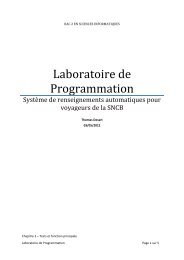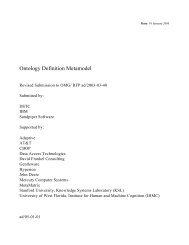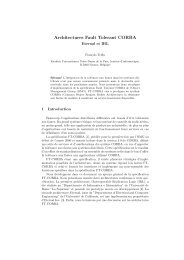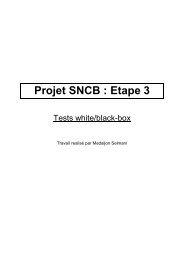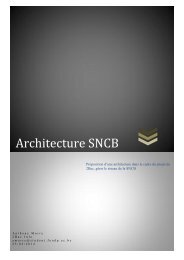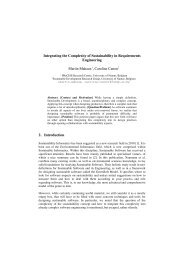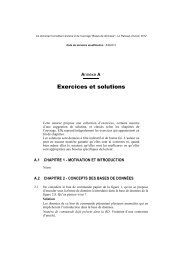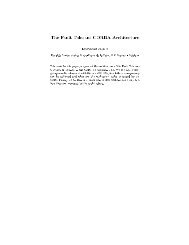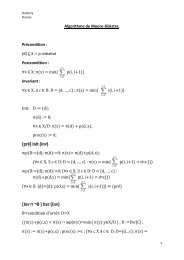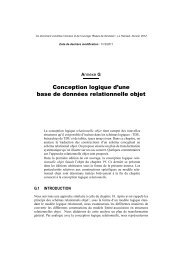Database Reverse Engineering - A Case Study - Institut d'Informatique
Database Reverse Engineering - A Case Study - Institut d'Informatique
Database Reverse Engineering - A Case Study - Institut d'Informatique
Create successful ePaper yourself
Turn your PDF publications into a flip-book with our unique Google optimized e-Paper software.
- The fields of each record type are prefixed with a common short-name identifying their the record type, and<br />
which bears no semantics. We trim them out.<br />
- Compound fields CUS.CUS-HIST and ORD.ORD-DETAIL have one component only, and can be<br />
disaggregates without structural or semantic loss.<br />
5.1.2 Physical cleaning<br />
The physical constructs, namely files and access keys, are no longer useful, and are removed.<br />
ORDER<br />
CODE<br />
CUSTOMER<br />
DETAILS[0-20]<br />
REF-DET-STK<br />
ORD-QTY<br />
id: CODE<br />
acc<br />
ref: DETAILS[*].REF-DET-STK<br />
ref: CUSTOMER<br />
acc<br />
id(DETAILS):<br />
REF-DET-STK<br />
STOCK<br />
CODE<br />
NAME<br />
LEVEL<br />
id: CODE<br />
CUSTOMER<br />
CODE<br />
DESCR<br />
NAME<br />
ADDRESS<br />
FUNCTION<br />
REC-DATE<br />
PURCH[0-100]<br />
REF-PURCH-STK<br />
TOT<br />
id: CODE<br />
ref: PURCH[*].REF-PURCH-STK<br />
id(PURCH):<br />
REF-PURCH-STK<br />
Figure 7. Reducing the names and removing physical constructs from the logical schema.<br />
5.2 Schema de-optimization<br />
The attributes CUSTOMER.PURCH and ORDER.DETAILS have a complex structure : they are compound,<br />
they are multivalued, they have a local identifier and they include a foreign key. They obviously suggest a<br />
typical COBOL trick to represent dependent entity types. This very efficient technique consists in<br />
representing such entity types by embedded multivalued fields. We transform the latter into entity types. The<br />
schema appears as in Fig. 8.<br />
ORDER<br />
CODE<br />
CUSTOMER<br />
id: CODE<br />
acc<br />
ref: CUSTOMER<br />
acc<br />
0-20<br />
ORD_DET<br />
1-1<br />
DETAILS<br />
REF-DET-STK<br />
ORD-QTY<br />
id: ORD_DET.ORDER<br />
REF-DET-STK<br />
ref: REF-DET-STK<br />
STOCK<br />
CODE<br />
NAME<br />
LEVEL<br />
id: CODE<br />
CUSTOMER<br />
CODE<br />
DESCR<br />
NAME<br />
ADDRESS<br />
FUNCTION<br />
REC-DATE<br />
id: CODE<br />
0-100<br />
CUS_PUR<br />
1-1<br />
PURCH<br />
REF-PURCH-STK<br />
TOT<br />
id: CUS_PUR.CUSTOMER<br />
REF-PURCH-STK<br />
ref: REF-PURCH-STK<br />
Figure 8. Making dependent entity types explicit.<br />
5.3 Schema untranslation<br />
The foreign keys are the most obvious traces of the ER/COBOL translation. We express them as one-tomany<br />
relationship types (Fig. 9).<br />
5.4 Conceptual normalization<br />
FIIA96 (04/04/07) 8



